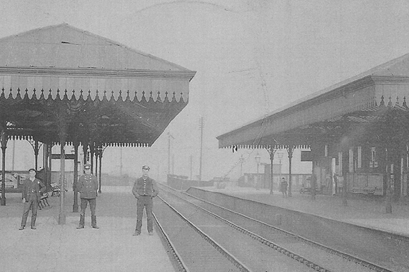
Local History

The history of the two villages of Irlewhelam (Irlam) and Cadwalenstate (Cadishead) can be traced back many hundreds of years. Strategically located at the crossing point of Chat Moss (for many years was an impenetrable peat bog) and the River Mersey, Great Woolden Hall Farm was once the site of Iron Age and Roman farmsteads.
For hundreds of years the two small villages survived on river trade. As the two great cities of Manchester and Liverpool grew, and as trade on the rivers increased and pack horses and carts carried goods between the two cities, so too did Irlam and Cadishead. The coming of the railways, first in 1830 when Robert Stephenson famously floated the Liverpool to Manchester Railway across Chat Moss, and a second line in 1873, started the industrialisation of both villages. To read the history of the railways in the district, click on The Railways of Irlam, Cadishead and Glazebrook pdf below, written by HDT’s Chair Neil McArthur.
In 1894 the navigation of the River Irwell and Mersey was replaced by the Manchester Ship Canal. The scene was now set for rapid growth as company after company sought canal side and rail access. Steel, soap, petrochemicals and food production employed thousands. Irlam and Cadishead boomed and shops lined the district from one end to the other. With industry came housing and many estates were built between and after the two world wars.
By the 1970s industry was changing and with it the district declined. By the 1980s new industry started to arrive and today we see virtually all of the old industrial sites regenerated with new businesses or housing developments. The canal is no longer a polluted industrial waterway and is host to a variety of wildlife. Chat Moss is not the vegetable garden it once was but offers 10 square miles of protected green belt. The street scene along Liverpool Road has undergone a transformation as too has Irlam Station and its surrounds – which is now a wonderful landmark for the area.
This is complemented by the A57 Cadishead Way Bypass, which was introduced a number of years ago to move commuting traffic and heavy goods vehicles to the outskirts of the district and follows the canal on its northern bank.
If you are interested in history – then why not get involved with the I&C History Society?
In the documents below, a wealth of history is shared within the HERITAGE BOARDS sited around the district. The project is ongoing and over time more of the heritage boards will be added to this page.
*A map has been produced of all the Heritage Boards and they have clickable stars that ‘pop up’ with information, click here to view.
There is also an I&C Art Trail map with the same clickable stars that have pop ups of information, click here to access.
Resources
- Heritage Board - Manchester Ship Canal - Download
- The Railways of Irlam, Cadishead and Glazebrook by Neil McArthur - Download
- Waterways Artwork by Rachelle - Download
- Heritage Board-Commercial Waterways Mersey & Irwell - Download
- Bob's Ferry Memorial - Download
- Cadishead 1st Station - Download
- Irlam Station - Download
- Irlam Station Drinking Fountain - Download
- Subway - Download
- Irlam Station Signal Box - Download
- The Three Bridges of Irlam - Download
- The Wheels of Local Industries - Download
- Margarine Works - Download
- Soap & Candle Works - Download
- Local Industries - Download
- Steelworks - Download
- The Kings Highway - Download


